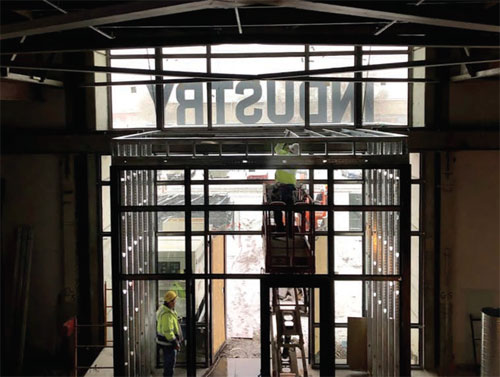By John Rogers
Salt Lake City’s blighted Granary District is taking on a new look.
The old industrial area on the edge of downtown is taking on new life thanks to the mergence of three forces: Qualified Opportunity Zones legislation created by the 2017 Tax Cuts and Jobs Act to spur economic development and job creation in distressed communities;{mprestriction ids="1,3"} Q Factor, a development team led by Jason and Ellen Winkler; and Catalyst Opportunity Funds, a Salt Lake City investment firm focused on Opportunity Zone investments and headed by renowned Utah investor Jim Sorenson.
Two rundown industrial complexes are the center of the transformative projects Q Factor has undertaken. Both are located in an area generally bounded by 600 South and 900 South between 300 West and Interstate 15. Known as the Granary District because of its history of flour production, its proximity to downtown and its abundance of abandoned warehouse and industrial buildings has attracted entrepreneurs and artists who see the area as blank canvases for eclectic and creative enterprises.
Q Factor’s first project, that partially opened in January, is being built out in an old 150,000-square-foot warehouse just south of 600 South at 500 West. Dubbed “Industry SLC,” the development is on the site of a 1900s foundry and is the first of several phases the Winklers envision on the 8.3-acre property they control. The couple has used the Industry name for similar projects in Colorado and Michigan.
The foundry property encompasses about 340,000 square feet where future Q Factor phases will consist of community and event space, shared amenity areas to support local businesses and residential workforce housing. Joining the Winklers in development of Industry SLC is Brandon Blaser of BCG Holdings, a Salt Lake City-based community development group.
Sorenson, well-known in Utah for his investment and philanthropic activities, said his company will invest a combined $28 million in qualified capital into Q Factor projects. He said that over the long run, Catalyst will utilize its proprietary impact scorecard to measure and track the economic, social and environmental impact each development has on its respective community.
“We set the bar high for ourselves in order to find projects that truly meet the spirit of the Opportunity Zone program’s purpose. We aim to be the model fund for this program and our work starts now with these projects,” said Sorenson, managing partner of Catalyst. “These are long-term investments aimed at spurring sustainable economic and community development. Our first investments are an example of what we plan to focus on moving forward, and we’ve identified a pipeline of developments across the country that we feel meet the strict qualifications we have for our Opportunity Zone investments.”
Q Factor’s second Granary District project, “Pickle & Hide,” will involve the renovation of adjacent derelict buildings on the 700 South block of 400 West. One of the building is the former site of the Utah Pickle Co., originally built by Heber J. Grant, former president of The Church of Jesus Christ of Latter-day Saints, as a soap factory and later as a pickle and condiment factory. The second building was once a tannery — thus the “Hide” name.
The Pickle & Hide project will create an impact and innovation campus with creative office and retail space, as well as social centers featuring outdoor gardens and community event areas, Q Factor said. It will also include affordable housing units for low- to moderate-income residents.
Q Factor is working closely with the Redevelopment Agency of Salt Lake City to create synergies between their joint mission of bringing vitality to the Granary District.
“These are not one-off developments, but rather calculated investments centered around longevity and anchored by job growth, affordable office space and community needs,” said Patrick McKenna, managing partner at Catalyst. “Job creation is at the core of community revitalization, and to do that we want to cultivate areas that draw in workers and businesses. This is core to our investment thesis with the Opportunity Zone program. We want to help spur this type of tangible change and target market-rate returns.”{/mprestriction}








